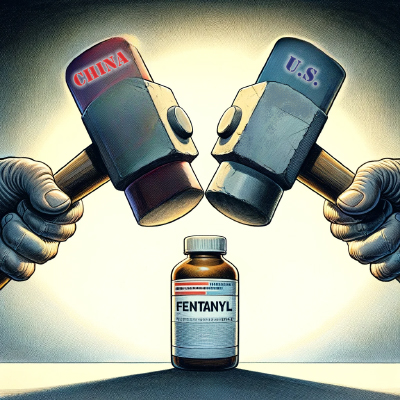During their summit in San Francisco, California, on November 15, 2023, Chinese President Xi Jinping and U.S. President Joe Biden announced continued cooperation on counternarcotics issues, and a crackdown on fentanyl in particular.
Interaction on a wide range of issues is an inevitable part of the mix in bilateral relations.
Although President Ronald Reagan launched a “War on Drugs” in the 1980s and all subsequent presidents continued it, the results are not encouraging. The drug crisis in the U.S. is more extensive, covering both the country’s urban and rural areas.
From the U.S. perspective, to solve the fentanyl issue, it not only needs domestic efforts, but also international cooperation with China, Mexico, Canada and India.
China-U.S. cooperation on counternarcotics and law enforcement is essential to the wellbeing of both countries. And continued cooperation in this field bodes well for Chinese and Americans this year.
Fighting the distribution of illegal fentanyl is a key concern.
A persistent problem
The drug epidemic in the U.S. flared up in the 1980s and has proceeded apace ever since.
Cocaine production ramped up in Colombia and the illegal drug made its way into the U.S. through the Caribbean, across the southern border with Mexico, and up into the state of California on the Pacific Coast.
The U.S. fentanyl crisis of the last decade is part of its broader historic drug crisis of the past four decades. The driving factor is U.S. demand for illegal drugs and this demand has steadily increased over the years owing to a number of socio-economic factors. And despite increased prevention efforts in local communities, overall demand has not reduced.
Drug smuggling operations involve criminal organizations in producer states, such as Colombia and Peru, teaming up with criminal organizations in Mexico. The very powerful Mexican organizations are known as “cartels” and several of them compete with each other for the North American market.
Americans spend over $150 billion a year on illegal drugs. The U.S. Government has spent over $1 trillion on its war on drugs, seemingly with little effect. The U.S. is the largest single market for illegal drugs on the planet.
The crisis in prescription opioid drugs arose in the country over the past 15 years. Legal painkillers were greatly over-prescribed by doctors and pushed on the public by unscrupulous pharmaceutical companies. Corruption in the medical community accounts for over prescription as well as for illicit diversion, impacting millions of Americans.
This opioid crisis set the stage for the fentanyl crisis by getting the public used to painkillers and overusing them.
The illegal diversion of legal painkillers to drug users created a whole new group of addicts. In turn, many in this group shifted toward heroin as it is cheaper on the street. The increased demand for heroin then became the occasion for the introduction of fentanyl into this expanding market.
Disaster is brewing
Following mass opioid and heroin addiction across the U.S., the fentanyl crisis intensified. Unlike plant-based cocaine and heroin, fentanyl is a synthetic opioid—or made directly from chemicals. These are known as “precursor” chemicals and they can be multiuse. It takes pharmaceutical grade laboratories to make fentanyl, which is 50 times more potent than heroin and 100 times more potent than morphine.
Fentanyl was introduced as a pharmaceutical drug in 1959. While some criminal diversion of legally produced fentanyl occurs in the U.S., the main problem by far is the illicit fentanyl smuggled into the country in different forms.
For example, ever increasing heroin use creates an opportunity for criminals to mix an amount of fentanyl into the heroin boosting its potency—and their profits. Fentanyl can also be sold on its own, mixed with a neutral base or mixed with other drugs.
In all cases, overdose is common and related deaths are increasing. Just a few tiny grains of illicit fentanyl can kill a person.
The actual chemical composition of fentanyl can vary depending on the formulas used to produce it. These variations are called “analogues.” Pharmaceutical fentanyl in the U.S. is authorized for legitimate medical use in humans as well as for veterinary use.
Anti-drug laws must extend to all chemical variations, or analogues, of illegally produced fentanyl to prevent evasion of criminal penalties for trafficking.
In the early stage of the fentanyl crisis over the past decade and a half, the illegal drug was smuggled into the U.S. through Canada across the border in the Pacific Northwest region of the U.S. Such shipments could be traced back to criminal organizations in Asia, with Hong Kong Special Administrative Region apparently a key center.
Later, a new smuggling pattern involved moving fentanyl across the southern border of the U.S. from Mexico. This has become the main way the drug enters the U.S. today. The Joe Biden administration opening the southern border wide to illegal immigration has only facilitated the smuggling of drugs into the country.
This new pattern came to involve the laboratory production of fentanyl in Mexico itself rather than in Asia. Some of the precursor chemicals are said to come from China. That is why Chinese authorities have cracked down on Chinese criminal organizations involved in this trade.
A new factor in the cross-border fentanyl trade is the recent linkage of criminal organizations in India with the Mexican cartels. This is because India has an advanced pharmaceutical industry and thus fentanyl production is known. The U.S. considers the transfer of Indian involvement and pharmaceutical methods to Mexican cartels a growing narcotics threat.
Enhancing cooperation
The U.S. and China for a number of years have been cooperating effectively on counternarcotics issues to include fentanyl. Cooperation was initiated by the Barack Obama administration and advanced professional interaction by law enforcement. The Donald Trump administration continued this effort.
The U.S. Drug Enforcement Agency (DEA) has a representative office in China and the U.S. Department of State handles the diplomatic side. The DEA mission in China supports local counternarcotics efforts. Such support involves investigations and the exchange of related information.
The DEA appreciates the level of cooperation and is developing its relationship with China in a professional, law-enforcement working style, according to officials. Successes have included crackdowns on major criminal fentanyl operations.
China has step by step introduced controls and updated the listing of drugs that are illegal to export from China, thereby rendering illicit exporters subject to criminal prosecution. In cooperation with the U.S., China in 2019 further updated the listing and classification of controlled substances, including fentanyl and its analogues.
Both the U.S. and China have undertaken important steps in recent years to schedule and control all fentanyl variations, including new ones once they are created. The objective of full and continuous control covers the entire class of fentanyl and fentanyl-related analogues.
Clearly, dangerous drugs are an international problem. The cooperation between China and the U.S. on fentanyl is significant, but it must be emphasized that the context must be global. The UN, related European organizations and India must all join in the close cooperation.
The author is a former senior staff member of the U.S. Senate Committee on Foreign Affairs and president of the Washington Institute for Peace and Development. This article was first published on the China Focus website–The Daily Mail-Beijing Review news exchange item





